Harvesting Swamp Cabbage
- "Center Third Cut Away"
- "Sabal Palm Eater"
- "Boot by Boot Peeling"
- "Tasting Begins"
- "Working for Food"
- "Filling The Bowl"
- "White But Too Pithy"
- "Amazing Structures Inside"
- "Removing The Edible Heart"
- "Premature Boots Above The Heart"
- "The First Pieces In The Bowl"
- "Healthy Sabal Palm Growing Up"
Over the course of this year we have had the good fortune to harvest and eat swamp cabbage, or the heart of the Sabal Palm three different times. The first tree fell casualty to our new shed. We had to do some clearing to get the shed in. That was the only tree other than some Brazilian Pepper Trees to be knocked over. The Brazilian Pepper trees are invasive non native trees. It was a great thing to knock them down.
I was interested to find that the Sabal or Cabbage Palm we took out had lost all of it’s boots and was smooth trunked, or as smooth as one can get. When I opened it up I found large black and red Palm Weevil beetles moving in around the boots at the top, and there were beetle larva in the white new boot growth of the interior. Over time they would have killed my palm, but the top was still green, and the heart of the palm was not yet damaged. This Palm tree was in the woods, and had never been pruned properly or improperly. I do worry that if the weevils were attacking it there was some weakness already there. The University of Florida has a recently discovered a palm bacterium that is attacking and killing the Sabal Palms here. It is the phytoplasma that has been causing the lethal yellowing disease in Canary Island Date Palms, Wild Date Palms and Queen Palms. I hope it is not ongoing in my palms. I haven’t yet contacted anyone about a test. New Sabal Palms come up on my property quickly and constantly. I am for now taking a watch and see attitude. I lost a pair of vigorous Queen Palms several years ago, but there was no yellowing first, they both just lost their centers and slowly died.
The second palm I harvested the heart from was up at the road in front of a neighbor’s house waiting to be picked up by waste removal services. My husband and I saw it there while walking the dogs, and hightailed it back to the house to get the truck and a hand saw. When we returned to the tree we cut the top fronds off, and loaded it up into the truck.
The last Cabbage Palm I harvested this year came off of my property. It was blocking the western exposure for several of my garden boxes. It was a young tree, maybe about 10′ high, not far from two others about the same size.
Harvesting Cabbage Palm hearts is not what anyone would call a sustainable practice, but if you have to take one out it is a good idea to plan to get the food out of it. If you don’t run into a Sabal Palm that has to be sacrificed you can also find it in the grocery store in the canned vegetable section. Even that harvest though is unsustainable, so I would call Palm Hearts a specialty occasion food only.
Even with the sharpest hatchet, the harvest process takes me over 4 hours. By the third harvest my time had not appreciably improved. This harvest is hard work, but when you get that big smooth cylinder of meat out of there it all seems worth the trouble. As I am chunking it out I save the edible parts in distilled water with a lot of lemon juice. That seems to keep it from browning. That is also how I store it in the refrigerator until I can use it. It is good like that for at least five days with a water/lemon juice change in between.
The Palm heart has a pleasant smooth crunchy texture and almost no flavor. As it goes down toward the more pithy inedible parts it gets bitter. I ate a good bit of that bitter part raw while working on it. It’s not bad while it is fresh! I used the rest of the harvest to make stir fry, added it raw to salad, and cooked up a bunch in a stew, most of which I froze for another day. All the other parts went into my compost.
The Sabal Palm is the State Tree for Florida and South Carolina. Indigenous people used the leaves for thatch roofing, the heart for food and chewed the berries for a headache remedy. It is a native plant in much of the south, drought tolerant, cold hardy and low maintenance.
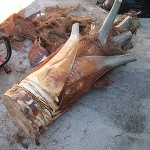

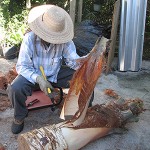
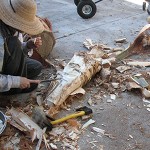
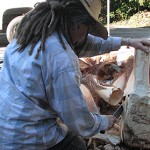
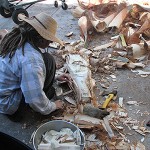
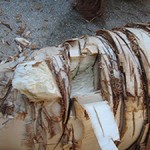
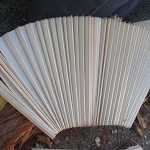
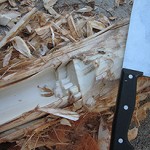
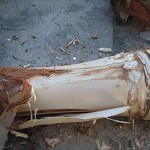
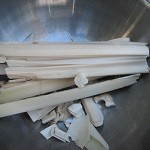
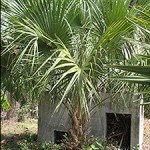

10 Responses
I know what you mean. Excellent post. It is a real luxury to eat after working your ass off to get at it!! Tastes great and well worth it.
I wonder how long after a tree is taken out of the ground is the heart good?And I wonder if cutting vs removing with rootball intact makes a difference?
Hey Danny thanks for your comment. You are right about getting good food for the work. I really like it too, but most environmentally responsible peeps want to play it down as a mostly tasteless luxury food because it is not sustainable, but in hard times, finding food with the work to obtain it as the price tag seems delicious. Swamp Cabbage filled in some hungry spaces during the great depression. It is good to know how to get this if it comes to that again.
Christine, It is always great to hear from you. I can count on you to come up with the hard questions. The palm we found on the side of the road had green fronds on it. I think if the fronds are green then it may be fine. How many days it takes for the fronds to die I couldn’t guess.
It would absolutely stay fresher longer if the whole tree roots and all came out, and especially if some effort was made to keep the root ball cool and moist. Thanks for your comment.
Thanks for a very informative post. I’ve lived in Fl for over 30 years and have eaten the canned Hearts of Palm. I’ve always wondered what part of the palm is eaten and how it is harvested and prepared. This is Foxfire type info: you never know when it will come in handy.
Thanks again!
-Chuck
Thanks for your comment Chuck.
I was browsing the web and found myself engrossed in this site.As a kid, at the age of 8 along with my family,we actually cut swamp cabbage for a living…sometimes as many as 400 to 600 a day.We canned it,as well as also cuting it for other purposes like fiber used in products such as wisk brooms,and some clothing.We would sell the palm frons which were used on the reservations for example to cover the roof tops of thier chiki huts.We would use the bitter of the cabbage to mulch and mix with feed for animal consumption.There are a lot of valuable resources that come from the swamp cabbage{Sabal Palm] that most people don’t even consider.In recent years the cabbage berries as most call them were found to be a beneficiary part of the medical field and are used in some vacines to treat things like cancer.But anyway I didn’t meanto ramble,like I said just found myself engrossed in the site and it brought back a lot of old memories.Thank you for your time..have a nice day.
Hey Lamar, Thanks for your comment. I can’t imagine cutting down 400 to 600 palms in a day and then the work that went into processing that many. I don’t imagine that was an easy life for a kid, but I’ll bet it kept you out of trouble! It is amazing how much resource comes from one tree. I use the parts I don’t eat in my compost. It breaks down very fast, I use the fronds to block out weeds on the ground, and the woody part of the trunk I use as pedestals on which to place my potted plants. When they break down they make a lovely fluffy material I call “palmpost”.
I have eaten Swamp Cabbage for many years, but never knew when the right time to harvest was. Does anyone now the best time to harvest this tree?
we sell boiled peanuts st sunshine fleamarket in lakewales but we will be selling swamp cabbage soon on the roadside snd peanuts as well. if you have a hankerin for some callme at 407-779-6746